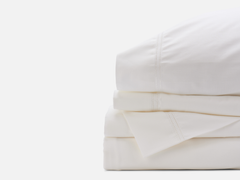We're throwing it back on this #TBT to when our founder and chief farmer, Mark Yeager appeared on the cover of Cotton Grower Magazine in August of 1997. Mark has always believed in growing big ideas and Red Land Cotton is no exception.
Read the full article below.

north alabama cotton grower/ginner has learned that money doesn't start ideas. rather —
IDEAS START MONEY
“If I were advising youngsters entering farming, I would tell them: Come up with good ideas and put them to work,” says Mark Yeager of Moulton, AL.
He ought to know. He started young, buying his first farm — 80 acres — in 1979, the year he finished high school. However, the young Alabaman envisioned bigger plans.
“In 1988, two major events took place in my life: I married Cassandra and started Red Land Farms,” Yeager says. Back then he grew corn and cotton on 750 acres. Less than a decade later, he established Yeager Gin Company and expanded Red Land’s acreage to 4,000, planting 2200 to cotton, 1600 to corn, 100 to soybeans, and 100 to Irish potatoes.
ginning potatoes
“Growing potatoes commercially was somewhat of a radical idea,” says Yeager. “No one here in Lawrence County had ever tried it before. Fortunately, we did really well our first year, harvesting about 13,000 pounds per acre, and since there’s an excellent red potato market, we’ll grow more in the future.”
Ideas spawn ideas. To prepare whole potatoes for planting, Yeager uses an automatic cutter, and he bought a potato planter. But where would he find facilities for washing, grading, invoicing and packaging the harvest? “My gin, of course,” Yeager chuckles. “We use the gin scales to weigh them, the gin office for paperwork, and the gin loading dock to forklift them into trucks.”
While Yeager is always exploring new ideas to make land produce more, cotton is still the mainstay. His weaker acres produce better than 600 pounds of lint, and the stronger ones yield closer to 900 pounds.
But cotton hasn’t always been good to Yeager. “I don’t irrigate, and in 1995 the severe drought and worm pressure forced me to look at alternative cropping methods,” he says.
Before 1995, Yeager grew cotton in monoculture, but where yields have begun to decline, he now rotates two years of cotton with one year of corn. While he is pleased with the benefits the soil derives from increased organic matter and the boost in cotton yields, he also feels mighty good about the corn’s performance. In 1996, he produced 100 bushels per acre on 1600 acres and sold the crop for an average $3.60 per bushel.
Farmland around Moulton is not exactly ironing board flat, nor is it all “ice cream,” and producing good crops requires different methods from those used in other areas. Yeager samples his soils yearly and applies phosphorous, potash, and lime in the fall. Before winter weather halts fieldwork, he performs major tillage, using moldboard plows, chisel plows, or subsoilers, then hopes for a few hard winter freezes to start pulverizing the large clods.
There are no rows to re-establish. Yeager plants flat. “Bedding has never worked well here,” he says. “In a 50-acre field, you might have four or five soil typed, not to mention the impracticality of running rows up and down hills.”
If April 10 is warm, if soil temperatures are acceptable, and if the forecast is promising, Yeager heads to the field. It’s planting time.
Two trips with the field cultivators pick up where Old Man Winter left off, and Do-Alls finish smoothing out. Yeager’s cotton performs best on about 60 units of nitrogen applied prior to planting as a liquid in a tankmix with a preplant herbicide.
Using 12-row equipment on 30-inch rows, Yeager plants 15 pounds of seed per acre. In 1996, he committed half of his cotton land to the transgenic variety NuCOTN 33B.
“The fact that 90% of the cotton acreage in this area was planted to Bt varieties is a good indication that they have a good indication that they have a place,” Yeager says, “but we could all get a clearer picture of what their true value is if the manufacturers would index prices to established yield averages. I think they are overpriced for our area. The grower has got to stay in business, and right now the profit margin is just too thin.”

introducing entomophages
Some of Yeager’s “new ideas” are really quite old. One has been around since the dawn of creation: bugs eat bugs. After the disastrous 1995 worm onslaught, Yeager wasn’t convinced that his combination of transgenics and dependence on pesticides to protect conventional varieties guaranteed there would be no repeat of that nightmare. He took our a little more insurance by trying biological pest control.
“I contacted two Californians with extensive beneficial insect experience: Bakersfield consultant Ed Davis and Jake Blehm, president of Buena Biosystems in Ventura,” Yeager says. “They explained that, in general, beneficial insects all work the same way, attacking specific pest populations and reducing them below economic injury levels.”
Yeager learned there are two beneficial types: parasites and predators. The parasitic Trichogramma wasp, for example, stings pest insects and deposits eggs inside them, killing the host and providing food for the offspring. Predatory beneficials such as the delicate-looking but deadly lacewing eat aphids, spider mites, and other soft-bodied pests.
In the predator camp, heavyweights include the ladybug, the predatory mite, the minute pirate bug, the big-eyed bug, and the praying mantis. Trichogramma is one of the most feared parasite denizens.
Friendly insects fit well in Yeager’s production strategy. “For me, they’ve proven to be a viable option, especially since they help me stay out of the fields early with organophosphates. And, they are relatively cheap. An acre’s worth of Trichogramma wasps is less expensive than a pyrethroid application.”
the 7.5 drill
New ideas. If Yeager thinks they have a chance of succeeding, he’s off and running. Last year on 100 acres of CRP land cover-cropped with fescue, he used a Great Plains drill to plant cotton on 7.5-inch rows in stubble behind a Roundup burndown. Estimated per-acre plant populations were in the 140,000 to 150,000 rand in this ultra-narrow row (UNR) experiment. To Yeager’s surprise, it outyielded conventional fields by about 200 pounds.

yeager gin company
Yeager built his gin from the ground up in 1994. “That year I has a new gin and three customers: myself, and two others,” he chuckles, “and I only ginned 2500 bales.”
But if you aren’t afraid to try new ideas, things often change in a hurry. Two seasons later, Yeager ginned 6500 bales for 15 growers.
Seeking to reduce bark content in the UNR cotton, Yeager is upgrading the gin’s pre-cleaning by installing a 120-inch Continental Eagle incline cleaner over Super III stick machines in tandem.
The gin processes 15 bales an hour with one Continental Golden Eagle Series Saw Gin stand, followed by two stages of lint cleaning. The finished product is baled in a Continental Eagle Bespress.
So after having grown from an 80-acre cattle farmer to a 4,000-acre diversified producer/ginner, where does a man at the ripe old age of 36 go? Yeager speaks from personal experience. “Most people know where they want to go in life,” he says. “The trouble is, they don’t always know how to get there. Three things do it for me: working hard, praying hard, and trying new ideas. The first is a prerequisite to the success of any human endeavor; the second is an obligation to the Giver of all good things, and the third is just an option, but on that has rewarded me time and again.”*
* Reed, Jimmy. "Ideas Start Money." Cotton Grower Aug. 1997: 10-11. Print.


